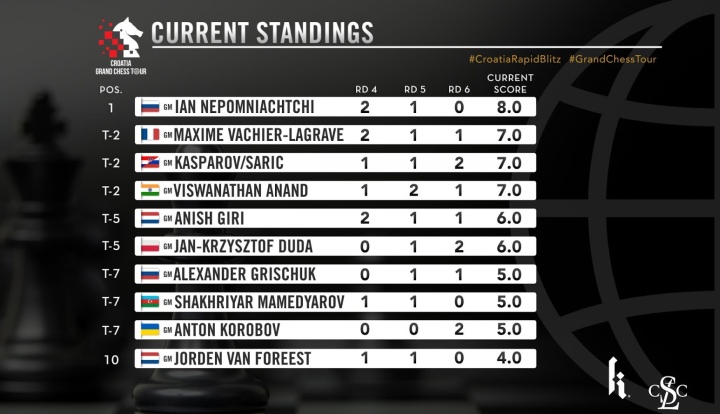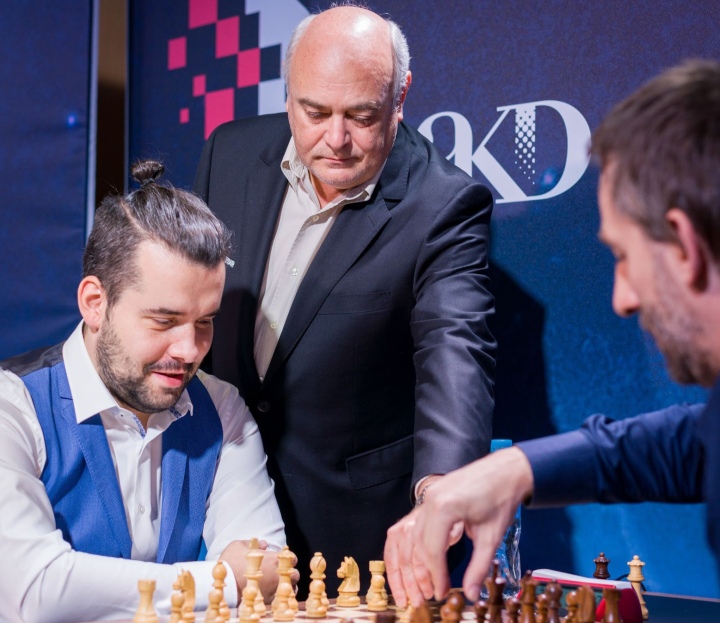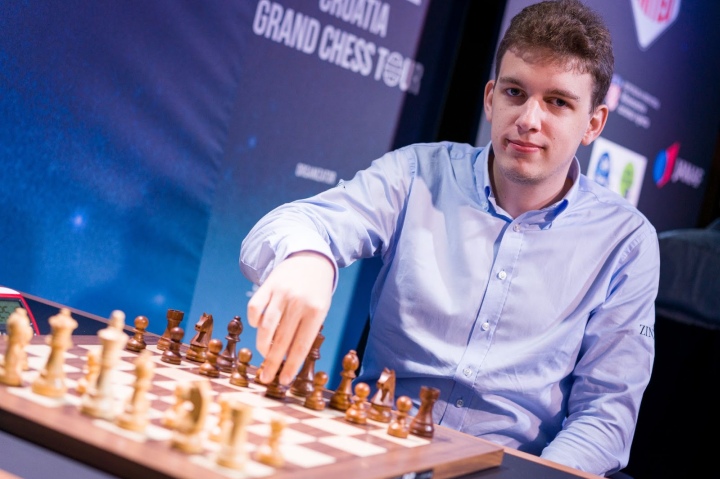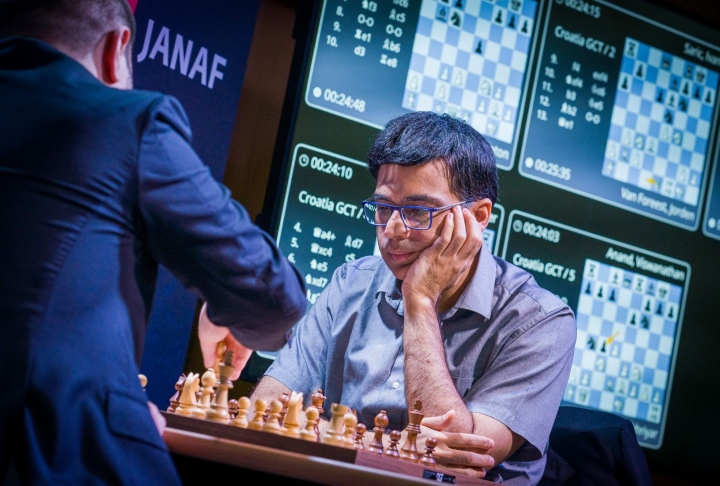Day two of the GCT Croatia Rapid & Blitz brought another exciting day of chess. The seven wildcard participants in this event are certainly keeping the tournament interesting and full of surprises. Though the day may have started off slow, as the time was running out for the players, many fumbles and surprises started to appear.

Round 4
The first game to finish in round 4 of the GCT Croatia was the one between the World Championship Challenger Ian Nepomniachtchi and his Russian compatriot Alexander Grischuk. In an equal position from an English Opening, Grischuk may have overpushed on move 18…d4 allowing Ian to activate his Bg2 and further transpose into an endgame which was slightly superior for White despite Black’s space advantage. Most likely due to the limited amount of time left, Grischuk misplaced and lost a pawn after which Nepo slowly converted extra material in the endgame. As the commentators put it: “It was a dominant performance by Nepo!”

In the game between Jorden Van Forrest-Ivan and Ivan Saric, it was White that kept the pressure throughout finding an interesting piece sacrifice: 26. Bxg6!? trying to weaken Black’s king. The piece was shortly recouped by the young Dutch player. The attack wasn’t strong enough, but he was able to retain an extra pawn in a rook endgame, which Saric held to a draw without much trouble.
It was a tough day at the office for the Ukrainian Grandmaster Anton Korobov and quite the comeback for the Duch player Anish Giri. In a Vienna Game, where it seemed that it was White who had a clearly better position, Korobov misplayed 18.Bd4?? failing to recover his pawn down from c6. 18.Bxc6! Had to be played instead. It was all that Giri needed to put pressure on White’s king, keep up the extra pawn and convert the rook and bishop endgame later on.
Shakhriyar Mamedyarov and Viswanathan Anand played a line in the Ragozin, where Black emerged with an extra pawn. Though White had some pressure on Black’s king due to the doubled f-pawns, Anand defended well and soon it seemed that he was heading to a much better position. He ended up in a knight and bishop endgame with an extra pawn, but it wasn’t enough to win against the strong Azeri GM.

The game between Maxime Vachier-Lagrave and Jan-Krzysztof Duda was the one that kept the audience breathless as it involved some interesting decisions and blunders from both sides. They played the Two-Knights Attack from the Caro-Kann which led to a balanced position. It was on move 28, where MVL chose to sacrifice a knight to open up Black’s king. It was a correct sacrifice, though it didn’t seem to bring him enough to build a mating attack. When Duda blundered with 33…Ne3??, the Frenchman found a way to win the queen for a rook and a bishop. The surprise happened when MVL chose to voluntarily (as he stated in the post-event interview) give back the queen with 40. Qf4?? and go into a rook endgame with an extra pawn and further a king and pawn endgame that should have normally ended in a draw. With little time on the clock and mistakes on both sides, Duda was the one that blundered last and lost the game.
Round 5
Round 5 was the round of missed opportunities for many players. Four of the five games ended in a draw. The man of the round was certainly 5-time World Champion Viswanathan Anand who took down the Ukrainian Grandmaster Anton Korobov. The game was not without ups and downs, however. In the Steinitz Variation of the French Defense, Anand went directly for 11.h4 delaying to bring his king to b1, as it is often played in this type of positions. As the game was unfolding, it seemed that Korobov was able to stop White’s king side attack and build more powerful one of his own on the queenside. Apparently, Korobov outplayed Anand, but made a mistake with 26…Rcd8? and succumbed to 27. Nf5! that allowed White to steer into a slightly better queen and bishop endgame. They later traded the queens into an opposite color bishop endgame that could have been a draw, but after being able to win all of Black’s pawns on the queenside, Anand was able to convert the game masterfully.

Both games of Ian Nepomniachtchi-Jan-Krzystof Duda and Alexander Grischuk- Shakhriyar Mamedyarov were played correctly leading to equal rook endgames that ended in all draws.
One of the tournament wildcards and local Grandmaster Ivan Saric had an interesting game against the French favorite Maxime Vachier-Lagrave. Though it started as a Sicillian, the game transposed to a French pawn structure, where MVL went for the typical break 15…f6 which allowed some advantage for White. Saric played confidently and even made a beautiful and typical positional exchange sacrifice 20. Rxe4! Accuracy would have been important for White to be able to continue keeping the pressure, but MVL defended ferociously and the game ended in a draw.
Another interesting game of the round was between the two Duch compatriots, Anish Giri and Jorden Van Foreest. It was towards the endgame that Jorden started making inaccuracies given his weaker pawn structure. Anish was able to get an upper hand in a rook endgame with better-placed rook and king. He missed a chance to win the rook endgame on move 41, where instead of capturing the a-pawn, he should have played 41.b6 creating a hiding spot for his king. As played, his king didn’t have a place to hide and it allowed Black to deliver checks. Despite the extra pawn, the rook endgame ended in a somewhat peaceful draw.
Round 6
Round 6 certainly brought more excitement in the eyes of the fans, as the current leader was taken down by the local star Ivan Saric. After about 20 moves theory in the Sveshnikov variation, it was Ivan Saric who seemed more confident than Ian Nepomniachtchi. Ivan had barely used any of his time, while Ian had already spent about 10 minutes, which is quite important in rapid chess. Ivan’s play was flawless and he dominated his opponent on the dark squares. It was certainly a painful loss for Nepo but he remains the sole leader of the event.
In an equal position from the Berlin Defense, Viswanathan Anand voluntarily sacrificed his queen with 22. Nd7 for a rook and a bishop against Alexander Grischuk. Though Black had some ideas of opening up the queen-side by pushing 31…b5-b4, Grischuck chose to trade knights allowing White to create a fortress, and the game ended in a draw shortly thereafter.
The game between Maxime Vachier-Lagrave and Giri Anish followed a well-known line of the Russian Defense and ended uneventfully in a draw.

Anton Korobov pressured the young Dutch player Jorden Van Foreest in a Vienna Game. Though the opening led to a symmetrical pawn structure, it was White that started winning space on the queenside. Probably pressured by the lack of space and struggling to find ways to activate his pieces he failed to find a way to protect his e5-pawn. He further sacrificed another pawn. With two extra pawns, Korobov didn’t have trouble converting the game.
Text: WGM Sabina Foisor
Photo: Grand Chess Tour, Lennart Ootes
Official website: grandchesstour.org/







